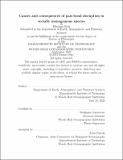Causes and consequences of pair-bond disruption in socially monogamous species
Author(s)
Sun, Ruijiao
DownloadThesis PDF (8.001Mb)
Advisor
Jenouvrier, Stéphanie
Terms of use
Metadata
Show full item recordAbstract
Many animals, from crustaceans to humans, form socially monogamous pair-bonds which are maintained during one or more consecutive breeding seasons. However, the ecological consequences of the disruption of monogamous pair-bond have rarely been addressed because it is difficult to estimate the rates and demographic impacts of pair-bond disruption (divorce or widowhood). This dissertation investigates the effect of global changes and individual heterogeneity on pair-bond disruption (divorce or widowhood) and their consequences for vital rates and life-history outcomes for socially monogamous species. In Chapter 2 and Chapter 4, analyses of long-term demographic datasets reveal different patterns of pair-bond dynamics between the population of wandering albatross (Diomedea exulans) breeding in sub-Antarctica and the snow petrel (Pagodroma nivea) breeding in Antarctica. In wandering albatross, divorce is nonadaptive with no improvement in breeding success, while divorce triggered by breeding failure is adaptive in Snow Petrels, resulting in a higher subsequent breeding success. Widowhood rates are male-biased due to lower survival rates of females in wandering albatrosses. In both wandering albatross and snow petrel, remaining single after a pair-bond disruption results in a reduction in individual lifetime reproductive success due to missed breeding seasons. Chapter 3 presents a link between individual personality and divorce in wandering albatrosses demonstrating the important implications of behavior types for the dynamics of social relationships. Personality was measured on a shy-bold continuum, linked to individual risk-taking tendencies, with bolder individuals more likely to take risks and shyer individuals. In wandering albatrosses, shyer males exhibit higher divorce rates than bolder males but no such relationship was found in females. Chapter 4 shows that environmental fluctuations can affect the prevalence of pair-bond disruption in snow petrels, with higher rates of pair-bond disruption under unfavorable environmental conditions. Moreover, the findings suggest a potential increase in the prevalence of pair-bond disruption towards the end of the current century. As a whole, this thesis advances our understanding of the effects of pair-bond disruption on demography which should not be ignored when providing guidelines for the conservation and management of endangered species.
Date issued
2023-09Department
Massachusetts Institute of Technology. Department of Earth, Atmospheric, and Planetary SciencesPublisher
Massachusetts Institute of Technology